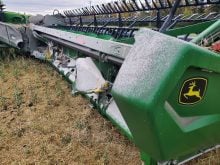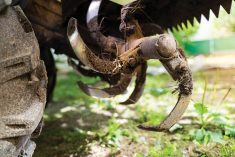Any energy source that could activate machinery poses a potential hazard on the farm. In a ranch or farm setting, the most obvious of these hazardous energy sources are mechanical: motor-driven equipment such as tractors, forklifts, conveyors, compressors, mixers and augers can cause harm if not properly managed. Suspended, elevated or coiled pieces of equipment are also potential energy sources that could strike or pin workers if they aren’t safeguarded.
Lockout procedures are crucial to making these machines inoperable during maintenance or when workers are in proximity. Lockout usually involves the use of a lock (one or more) that renders the machinery or equipment inoperable. The purpose is to prevent an energy-isolating device— such as a switch, circuit breaker or valve — from being inadvertently turned on while workers are clearing obstructions or doing maintenance on or near the machinery.
Before locking out machinery or equipment, ensure the energy is removed (de-energize). Lockout can be very straightforward. It can be as simple as taking the key out of a tractor’s ignition (de-energize) and keeping that key in a pocket (lock).
Here’s a straightforward guide to lockout basics.

When to lockout
Lockout is essential in the following situations:
- When machinery or equipment is shut down for maintenance or repair.
- During normal production if workers are at risk of injury from movement of machinery/equipment or if exposed to inadequately safeguarded energy sources.
- If machinery or equipment has moving parts and exposes a worker to the risk of injury if effective safeguards are not in place.
Steps to lockout
Step 1: Identify
Determine which machinery or equipment needs to be locked out by conducting a hazard analysis and risk assessment.
Step 2: Shut off
Turn off the machinery or equipment, ensuring all moving parts have completely stopped. Ensure shutting off the equipment doesn’t create hazards for other workers.
Read Also

Claas brings 1000 Series SP forage harvesters to Canada
In mid-August, Claas unveiled its new line of Jaguar forage harvesters at an event in Visalia, California, deep in the heart of that state’s dairy region.
Step 3: Deactivate
Identify and deactivate the main energy-isolating device for each energy source, such as the master power switch.
Step 4: Lock
Put a personal lock on the energy-isolating device for each energy source. Secure all parts and attachments to prevent inadvertent movement.
Step 5: Test
Test the lockout to ensure it’s effective. Verify that each energy source has been successfully locked out. Before testing, ensure all workers are safe, and no hazards will be created if the lockout fails.
By following these steps, you can significantly reduce the risks associated with machinery and equipment on the farm, creating a safer working environment for everyone. For more information on farm safety, visit the CASA website.















